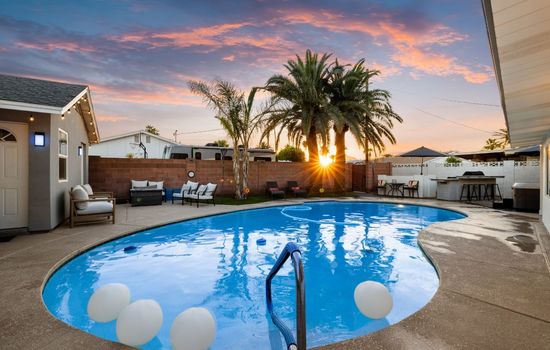The Sonoran Desert National Monument does not have a specified visitor center with set hours, but it is best to visit from late October to mid-April for optimal conditions.
There is no entrance fee for the Sonoran Desert National Monument, but some areas like the Sand Tank Mountains require a Barry M. Goldwater Range permit.
From Phoenix, take I-10 south to I-8, then west to Exit 144/Vekol Road, and turn south into a vast, arid landscape of cacti and golden sunsets near Gila Bend.
Parking is limited to rough dirt roads and small pull-outs, no designated lots. High-clearance vehicles recommended. No overnight parking, no fees. Suitable for small RVs, cars, and motorcycles.
Accessibility & permits
Emergency
- Cell service availability:Partial
Information not accurate?
Help us improve by making a suggestion.
In the heart of south central Arizona, the Sonoran Desert National Monument unfolds as a vast and biodiverse tapestry, 60 miles from the urban hub of Phoenix. This national monument is a paradigm of the Sonoran Desert’s unique beauty, boasting an extensive saguaro cactus forest that stands as a sentinel of the desert’s resilience.
The landscape is punctuated by three distinct mountain ranges: the Maricopa, Sand Tank, and Table Top mountains, along with the Booth and White hills, all separated by expansive valleys. These natural formations create a dramatic backdrop for a variety of activities, including hiking, horseback riding, and biking. The North Maricopa Mountains Wilderness, South Maricopa Mountains Wilderness, and Table Top Wilderness areas offer solitude and unconfined recreation, with trails such as the Margie’s Cove Trail, Brittlebush Trail, Lava Flow Trail, and Table Top Trail inviting explorers to delve into the wilderness.
Historical significance is woven into the fabric of the monument, with remnants of the Juan Bautista de Anza National Historic Trail and the Anza Trail Historic Campsite #26 at Arroyo Seco, where the Anza expedition camped in 1775. The monument also features archaeological and historic sites, adding layers of depth to the natural beauty.
Seasonal changes bring subtle shifts in the desert’s palette; the spring blooms with vibrant wildflowers, while the summer sun casts a golden glow over the landscape. As the seasons transition, the desert transforms, offering a new experience with each visit.
For those seeking a deeper connection with the land, local outfitters and guides offer insights into the monument’s unique flora and fauna. The nearby town of Gila Bend provides a quaint contrast to the vast desert, with its own charm and local artisans. While there are no lakes here, the Sonoran Desert National Monument is a destination that promises an immersive experience, rich in natural beauty, historical significance, and the allure of the untamed desert landscape.
- Area (mi²)
- 771
- Annual visitors
- 37 972
- Established year
- 2001
Top 3 Facts about Sonoran Desert National Monument
The monument features the Anza Trail, a 1,200-mile historic route that spans from Sonora, Mexico, to San Francisco, with an interpretive sign marking a trailhead along Maricopa Road. Access to the Sand Tank Mountains requires a permit and watching a 13-minute safety video.
Explore a realm of unparalleled biodiversity, where columnar cacti stand tall alongside conifers and native ferns. Here, over 2,000 plant species thrive, including the rare Acuña cactus. Witness the desert tortoise, cactus ferruginous pygmy-owl, and Sonoran pronghorn in their natural habitat. With 159 bird species, 36 reptiles, and 28 mammals, this landscape is a haven for wildlife enthusiasts. Discover the Sonoran green toad, lowland burrowing treefrog, and Abert’s towhee, each with unique adaptations to this arid yet vibrant ecosystem.
In the heart of this desert landscape, three distinct mountain ranges – Maricopa, Sand Tank, and Table Top – rise against the sky, separated by vast valleys. The Saguarro cactus forests thrive here, adding a vibrant green to the arid terrain. Temperatures soar during the day, while nights can drop dramatically, creating a dramatic climate contrast. The mountains, some reaching elevations over 4,000 feet, offer breathtaking vistas and unique rock formations, making this a paradise for those seeking an immersive natural experience.
Family programs
- Self-guided Tours
- Workshops & Hands-on Activities
- Scavenger Hunts
- Night Sky & Astronomy
- Family Camping & Overnight
- Volunteer & Stewardship
Travel Tips
Plan Ahead
Plan a few days for this vast terrain, especially during the cooler winter months. Rent a high-clearance vehicle to navigate unpaved roads. Pack layers for cold nights and hydration for hikes. Visit the trailheads early to avoid summer heat. Rest at scenic spots and bring meals, as options are limited. Catch the stunning sunsets and star-filled nights.
Pack Appropriately
Pack layers for extreme temperature fluctuations, sturdy hiking shoes, sunscreen, a headlamp, and ample water to stay safe and comfortable in the harsh desert environment.
Respect Wildlife
Respect wildlife by observing from a distance, staying on marked paths, and avoiding sensitive times. Secure trash and food to protect unique flora and fauna. Stay hydrated and aware of heat exhaustion signs. Leave the area as you found it.
Stay Informed
Stay hydrated, avoid hiking during peak heat, and watch for wildlife. Check weather forecasts and fire restrictions. For emergencies, call 911 or park authorities. Exercise caution on trails and near water features. Rest often and stay informed.
Seasons
Spring in the Sonoran Desert: Mild temperatures (71.9°F highs, 43.8°F lows) from February to April. Witness spring bird migration, vibrant wildflowers, and increased butterfly activity. Don’t miss the peak bloom of winter annuals like poppies and lupines, usually in mid-March. Ideal for outdoor enthusiasts.
Summer brings scorching temperatures up to 110°F, making it challenging for visitors. However, the monsoon season in July and August can bring dramatic thunderstorms. While not ideal for hiking, it’s a unique time to witness the desert’s vibrant flora and fauna. No special events are scheduled during this period, but the nocturnal wildlife and star-filled skies are unparalleled. Visit from late October to mid-April for a more comfortable experience.
Experience the Sonoran Desert in fall, from late September to November, with mild temperatures (60s-70s Fahrenheit) and occasional light rains. Witness the Saguaro Harvest Weekend, as resident birds feast on fruit and wintering hawks arrive. Ideal for nature enthusiasts, despite some snake activity. Be aware of potential illegal activities south of Interstate 8.
Visit from December to February for mild days with temperatures in the 60s and 70s, cool nights, and occasional light rains. A serene time to explore, with fewer crowds and vibrant winter flora.
Information not accurate?
Help us improve by making a suggestion.
Where to stay
Frequently Asked Questions
Ready to dive into what Sonoran Desert National Monument has to offer? Let’s tackle some of the burning questions you might have as you plan your visit!
-
The distance from Phoenix to the Sonoran Desert National Monument is approximately 59.2 miles, taking about 2 hours and 19 minutes to drive. You can take Interstate 10 west and then State Route 85 south to get there. The monument is located about 60 miles southwest of Phoenix.
-
You can bring your dog to the external areas, but they must wear a collar with current tags and be kept on a leash. Dogs are not allowed inside buildings, except for trained service animals. Always check the park’s website for specific leash laws and guidelines.
-
You can camp overnight in your RV, but there are specific rules and locations. The Painted Rock Petroglyph Campground has 59 campsites and can accommodate RVs, while the Gila Bend KOA Journey, adjacent to the monument, offers amenities like hook-ups and a swimming pool for larger rigs. Dispersed camping areas are also available but have limited services.
-
You can hike, camp, ride horses, and go biking at the monument. It also offers opportunities for stargazing, photography, and wildlife viewing. Additionally, you can explore historic sites like the Anza Trail Historic Campsite #26, which dates back to November 7, 1775.



